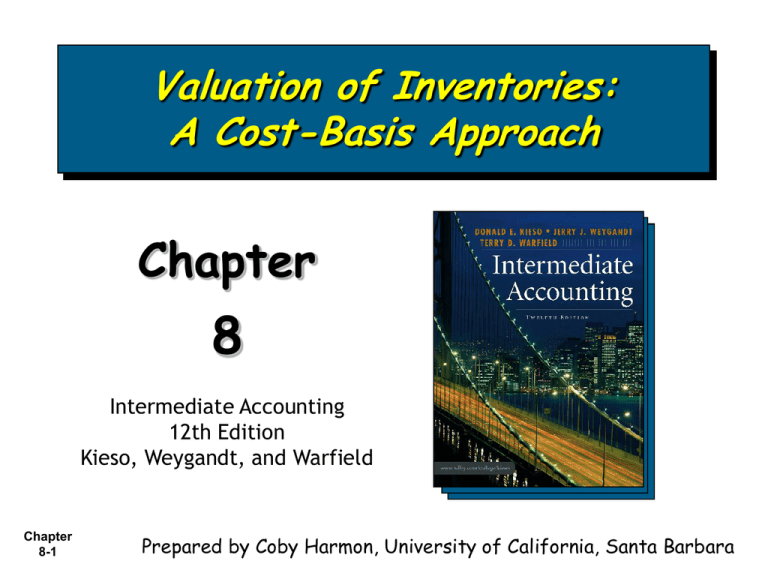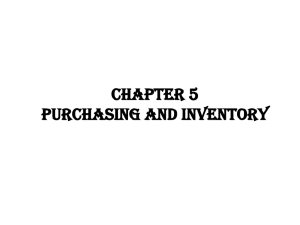
Valuation of Inventories:
A Cost-Basis Approach
Chapter
8
Intermediate Accounting
12th Edition
Kieso, Weygandt, and Warfield
Chapter
8-1
Prepared by Coby Harmon, University of California, Santa Barbara
Learning Objectives
1.
Identify major classifications of inventory.
2.
Distinguish between perpetual and periodic inventory systems.
3.
Identify the effects of inventory errors on the financial
statements.
4.
Understand the items to include as inventory cost.
5.
Describe and compare the cost flow assumptions used to account
for inventories.
6.
Explain the significance and use of a LIFO reserve.
7.
Understand the effect of LIFO liquidations.
8.
Explain the dollar-value LIFO method.
9.
Identify the major advantages and disadvantages of LIFO.
10. Understand why companies select given inventory methods.
Chapter
8-2
Valuation of Inventories:
Cost-basis Approach
Inventory
Classification
and Control
Classification
Control
Basic
inventory
valuation
issues
Chapter
8-3
Physical
Goods
Included in
Inventory
Goods in
transit
Consigned
goods
Special sales
agreements
Inventory
errors
Costs
Included
in Inventory
Product costs
Period costs
Purchase
discounts
Cost Flow
Assumptions
Specific
identification
Average cost
FIFO
LIFO
LIFO:
Special
Issues
LIFO reserve
LIFO
liquidation
Dollar-value
LIFO
Comparison of
LIFO
approaches
Advantages of
LIFO
Disadvantages
of LIFO
Basis for
Selection
Summary of
inventory
valuation
methods
Inventory Classification and Systems
Classification
Inventories are:
items held for sale, or
goods to be used in the production of goods to be sold.
Businesses with Inventory:
Merchandiser
Chapter
8-4
or
Manufacturer
LO 1 Identify major classifications of inventory.
Inventory Classification and Systems
Type of Business
Merchandiser
One inventory
account
Purchase goods
ready for sale
Chapter
8-5
Balance Sheet (in thousands)
Current assets
Cash
Marketable securities
Accounts receivable
Merchandise inventory
Prepaids
Total current assets
Investments:
Invesment in ABC bonds
Investment in UC Inc.
Notes receivable
Land held for speculation
Sinking fund
Pension fund
$ 285,000
530,000
149,000
777,000
33,000
1,774,000
321,657
253,980
150,000
550,000
225,000
653,798
LO 1 Identify major classifications of inventory.
Inventory Classification and Systems
Type of Business
Manufacturer
Three accounts
Raw materials
Work in process
Finished goods
Balance Sheet (in thousands)
Current assets
Cash
Marketable securities
Accounts receivable
Inventory
Raw materials
Work in process
Finished goods
Total inventory
$ 285,000
530,000
149,000
Prepaids
Total current assets
33,000
1,774,000
210,000
417,000
150,000
777,000
Investments:
Invesment in ABC bonds
Chapter
8-6
321,657
LO 1 Identify major classifications of inventory.
Inventory Classification and Systems
Flow of Costs
Chapter
8-7
Illustration 8-2
LO 1 Identify major classifications of inventory.
Inventory Classification and Systems
Control
Two systems for maintaining inventory records:
Perpetual system
Periodic system
Chapter
8-8
LO 2 Distinguish between perpetual and periodic inventory systems.
Inventory Classification and Systems
Perpetual System
Features:
1.
Purchases of merchandise are debited to Inventory.
2. Freight-in, purchase returns and allowances, and
purchase discounts are recorded in Inventory.
3. Cost of goods sold is debited and Inventory is
credited for each sale.
4. Physical count done to verify Inventory balance.
The perpetual inventory system provides a continuous
record of Inventory and Cost of Goods Sold.
Chapter
8-9
LO 2 Distinguish between perpetual and periodic inventory systems.
Inventory Classification and Systems
Periodic System
Features:
1.
Purchases of merchandise are debited to Purchases.
2. Ending Inventory determined by physical count.
3. Calculation of Cost of Goods Sold:
Beginning inventory
Purchases, net
Goods available for sale
Ending inventory
Cost of goods sold
Chapter
8-10
$ 100,000
800,000
900,000
125,000
$ 775,000
LO 2 Distinguish between perpetual and periodic inventory systems.
Inventory Classification and Systems
Perpetual System
vs.
Periodic System
|
1. Beginning inventory (100 units at $7 = 700)
|
2. Purchase 900 units at $7:
|
|
Inventory
Accounts payable
6,300
|
6,300
|
Purchases
Accounts payable
6,300
Accounts receivable
Sales
8,400
6,300
|
3. Sale of 600 untis at $14:
|
|
Accounts receivable
Sales
Cost of goods sold
Inventory
8,400
|
8,400
4,200
|
8,400
|
4,200
|
|
4. Adjusting entries (ending inventory = 400 units @ $7 = $2,800)
|
No Entry Necessary
|
|
|
Chapter
8-11
Inventory
Cost of goods sold
Purchases
2,100
4,200
6,300
LO 2 Distinguish between perpetual and periodic inventory systems.
Basic Issues in Inventory Valuation
Valuation of Inventories
Requires the following:
The physical goods (goods on hand, goods in transit,
consigned goods, special sales agreements).
The costs to include (product vs. period costs).
The cost flow assumption (FIFO, LIFO, Average cost,
Specific Identification, Retail, etc.).
Chapter
8-12
LO 2 Distinguish between perpetual and periodic inventory systems.
Physical Goods Included in Inventory
Physical Goods
A company should record purchases when it
obtains legal title to the goods.
Special Consideration:
Goods in Transit (FOB shipping point, FOB destination)
Consigned goods
Sales with buyback agreement
Sales with high rates of return
Sales on installment
Inventory errors
Chapter
8-13
LO 2 Distinguish between perpetual and periodic inventory systems.
Effect of Inventory Errors
Ending Inventory Understated
Illustration 8-6
The effect of an error on net income in one year (2006) will be
counterbalanced in the next (2007), however the income statement
will be misstated for both years.
Chapter
8-14
LO 3 Identify the effects of inventory errors on the financial statements.
Effect of Inventory Errors
Purchases and Inventory Understated
Illustration 8-8
The understatement does not affect cost of goods sold and net
income because the errors offset one another.
Chapter
8-15
LO 3 Identify the effects of inventory errors on the financial statements.
Costs Included in Inventory
Product Costs - costs directly connected with
bringing the goods to the buyer’s place of
business and converting such goods to a salable
condition.
Period Costs – generally selling, general, and
administrative expenses.
Purchase Discounts – Gross vs. Net Method
Chapter
8-16
LO 4 Understand the items to include as inventory cost.
Treatment of Purchase Discounts
Gross Method
vs.
Net Method
|
Purchase cost $20,000, terms 2/10, net 30:
|
Purchases
Accounts payable
20,000
|
20,000
|
Purchases
Accounts payable
19,600
19,600
|
Invoices of $15,000 are paid within discount period:
|
Accounts payable
Purchase discounts
Cash
15,000
|
300
14,700
|
Accounts payable
Cash
14,700
14,700
|
|
Invoices of $5,000 are paid after discount period:
|
Accounts payable
Cash
5,000
|
5,000
|
|
Chapter
8-17
Accounts payable
Purchase discount lost
Cash
4,900
100
5,000
LO 4 Understand the items to include as inventory cost.
What Cost Flow Assumption to Adopt?
FIFO
LIFO
Cost Flow Assumption Adopted
does not need to equal
Physical Movement of Goods
Average Cost
Specific Identification
Answer: Method adopted should be one
that most clearly reflects periodic income.
Chapter
8-18
LO 5 Describe and compare the cost flow assumptions
used to account for inventories.
Cost Flow Assumptions
Example
Young & Crazy Company makes the following purchases:
1.
One item on 2/2/07 for $10
2.
One item on 2/15/07 for $15
3.
One item on 2/25/07 for $20
Young & Crazy Company sells one item on 2/28/07 for
$90. What would be the balance of ending inventory and
cost of goods sold for the month ended Feb. 2007,
assuming the company used the FIFO, LIFO, Average
Cost, and Specific Identification cost flow assumptions?
Assume a tax rate of 30%.
Chapter
8-19
LO 5 Describe and compare the cost flow assumptions
used to account for inventories.
Cost Flow Assumptions
“First-In-First-Out (FIFO)”
Inventory
Balance = $ 45
Purchase on
2/25/07 for $20
Purchase on
2/15/07 for $15
Purchase on
2/2/07 for $10
Chapter
8-20
Young & Crazy Company
Income Statement
For the Month of Feb. 2007
Sales
Cost of goods sold
Gross profit
Expenses:
Administrative
Selling
Interest
Total expenses
Income before tax
Taxes
Net Income
$ 90
0
90
14
12
7
33
57
17
$ 40
LO 5 Describe and compare the cost flow assumptions
used to account for inventories.
Cost Flow Assumptions
“First-In-First-Out (FIFO)”
Inventory
Balance = $ 35
Purchase on
2/25/07 for $20
Purchase on
2/15/07 for $15
Purchase on
2/2/07 for $10
Chapter
8-21
Young & Crazy Company
Income Statement
For the Month of Feb. 2007
Sales
Cost of goods sold
Gross profit
Expenses:
Administrative
Selling
Interest
Total expenses
Income before tax
Taxes
Net Income
$ 90
10
80
14
12
7
33
47
14
$ 33
LO 5 Describe and compare the cost flow assumptions
used to account for inventories.
Cost Flow Assumptions
“Last-In-First-Out (LIFO)”
Inventory
Balance = $ 45
Purchase on
2/25/07 for $20
Purchase on
2/15/07 for $15
Purchase on
2/2/07 for $10
Chapter
8-22
Young & Crazy Company
Income Statement
For the Month of Feb. 2007
Sales
Cost of goods sold
Gross profit
Expenses:
Administrative
Selling
Interest
Total expenses
Income before tax
Taxes
Net Income
$ 90
0
90
14
12
7
33
57
17
$ 40
LO 5 Describe and compare the cost flow assumptions
used to account for inventories.
Cost Flow Assumptions
“Last-In-First-Out (LIFO)”
Inventory
Balance = $ 25
Purchase on
2/25/07 for $20
Purchase on
2/15/07 for $15
Purchase on
2/2/07 for $10
Chapter
8-23
Young & Crazy Company
Income Statement
For the Month of Feb. 2007
Sales
Cost of goods sold
Gross profit
Expenses:
Administrative
Selling
Interest
Total expenses
Income before tax
Taxes
Net Income
$ 90
20
70
14
12
7
33
37
11
$ 26
LO 5 Describe and compare the cost flow assumptions
used to account for inventories.
Cost Flow Assumptions
“Average Cost”
Inventory
Balance = $ 45
Purchase on
2/25/07 for $20
Purchase on
2/15/07 for $15
Purchase on
2/2/07 for $10
Chapter
8-24
Young & Crazy Company
Income Statement
For the Month of Feb. 2007
Sales
Cost of goods sold
Gross profit
Expenses:
Administrative
Selling
Interest
Total expenses
Income before tax
Taxes
Net Income
$ 90
0
90
14
12
7
33
57
17
$ 40
LO 5 Describe and compare the cost flow assumptions
used to account for inventories.
Cost Flow Assumptions
“Average Cost”
Inventory
Balance = $ 30
Purchase on
2/25/07 for $20
Purchase on
2/15/07 for $15
Purchase on
2/2/07 for $10
Chapter
8-25
Young & Crazy Company
Income Statement
For the Month of Feb. 2007
Sales
Cost of goods sold
Gross profit
Expenses:
Administrative
Selling
Interest
Total expenses
Income before tax
Taxes
Net Income
$ 90
15
75
14
12
7
33
42
12
$ 30
LO 5 Describe and compare the cost flow assumptions
used to account for inventories.
Cost Flow Assumptions
“Specific Identification”
Inventory
Balance = $ 45
Purchase on
2/25/07 for $20
Purchase on
2/15/07 for $15
Purchase on
2/2/07 for $10
Chapter
8-26
Young & Crazy Company
Income Statement
For the Month of Feb. 2007
Sales
Cost of goods sold
Gross profit
Expenses:
Administrative
Selling
Interest
Total expenses
Income before tax
Taxes
Net Income
$ 90
0
90
14
12
7
33
57
17
$ 40
LO 5 Describe and compare the cost flow assumptions
used to account for inventories.
Cost Flow Assumptions
“Specific Identification”
Inventory
Balance = $ 45
Purchase on
2/25/07 for $20
Purchase on
2/15/07 for $15
Purchase on
2/2/07 for $10
Chapter
8-27
Young & Crazy Company
Income Statement
For the Month
Feb. 2007
Depends
whichof one
is sold
Sales
Cost of goods sold
Gross profit
Expenses:
Administrative
Selling
Interest
Total expenses
Income before tax
Taxes
Net Income
$ 90
0
90
14
12
7
33
57
17
$ 40
LO 5 Describe and compare the cost flow assumptions
used to account for inventories.
Cost Flow Assumptions
Financial Statement Summary
Sales
Cost of goods sold
Gross profit
Operating expenses:
Administrative
Selling
Interest
Total expenses
Income before taxes
Income tax expense
Net income
Inventory Balance
Chapter
8-28
FIFO
$ 90
10
80
LIFO
$ 90
20
70
Average
$ 90
15
75
14
12
7
33
47
14
33
14
12
7
33
37
11
26
14
12
7
33
42
12
30
$
35
$
25
$
30
LO 5 Describe and compare the cost flow assumptions
used to account for inventories.
Cost Flow Assumptions
Example – Perpetual and Periodic Methods
Inventory information for Part 686 for the month of June.
June
1
Beg. Balance
300 units @ $10 = $ 3,000
10
Sold
200 units @ $24
11
Purchased
800 units @ $12 =
15
Sold
500 units @ $25
20
Purchased
500 units @ $13 =
27
Sold
300 units @ $27
9,600
Goods
Available
$19,100
6,500
1. Assuming the Perpetual Inventory Method, compute the Cost of Goods
Sold and Ending Inventory under FIFO, LIFO, and Average cost.
2. Assuming the Periodic Inventory Method, compute the Cost of Goods
Sold and Ending Inventory under FIFO, LIFO, and Average cost.
Chapter
8-29
LO 5 Describe and compare the cost flow assumptions
used to account for inventories.
Cost Flow Assumptions
Perpetual
Inventory
+
FIFO Method
FIFO:
Transactions:
Inventory Balance:
Date
Units
Layer 1
Layer 2
Layer 3
Jun 1
300
300
Jun 10
(200)
(200)
Jun 11
800
800
Jun 15
(500)
(100)
(400)
Jun 20
500
500
Jun 27
(300)
(300)
100
500
Cost
$
10 $
12 $
13
600
$
$ 1,200 $
6,500
Calculation of Cost of Goods Sold:
Beg. inventory
Purchases
Goods available
Ending inventory
COGS
Chapter
8-30
Total
600
$
7,700
Units
Dollars
300 $
3,000
1,300
16,100
1,600
19,100
(600)
(7,700)
1,000 $ 11,400
LO 5 Describe and compare the cost flow assumptions
used to account for inventories.
Cost Flow Assumptions
Perpetual
Inventory
+
LIFO Method
LIFO:
Transactions:
Inventory Balance:
Date
Units
Layer 1
Layer 2
Layer 3
Total
Jun 1
300
300
Jun 10
(200)
(200)
Jun 11
800
800
Jun 15
(500)
(500)
Jun 20
500
500
Jun 27
(300)
(300)
100
300
200
600
Cost
$
10 $
12 $
13
600
$ 1,000 $ 3,600 $
2,600 $
7,200
Calculation of Cost of Goods Sold:
Beg. inventory
Purchases
Goods available
Ending inventory
COGS
Chapter
8-31
Units
Dollars
300 $
3,000
1,300
16,100
1,600
19,100
(600)
(7,200)
1,000 $ 11,900
LO 5 Describe and compare the cost flow assumptions
used to account for inventories.
Cost Flow Assumptions
Perpetual Inventory
Transactions:
Date
Units
Jun 1
300
Jun 10
(200)
Jun 11
800
Jun 15
(500)
Jun 20
500
Jun 27
(300)
600
Cost
$ 10.00
10.00
12.00
11.78
13.00
12.46
Cost of Goods Sold:
Beg. inventory
Purchases
Goods available
Ending inventory
COGS
Chapter
8-32
Total
$ 3,000
(2,000)
9,600
(5,890)
6,500
(3,738)
$ 7,472
+
Moving Average
Running Balances Average
Units
Cost
Cost
300
$ 3,000 $ 10.00
100
1,000
10.00
900
10,600
11.78
400
4,710
11.78
900
11,210
12.46
600
7,472
12.46
Cost per unit
sold is
determined by
dividing total
inventory $ by
total units on
hand after each
purchase.
Units
Dollars
300 $ 3,000
1,300
16,100
1,600
19,100
(600)
(7,472)
1,000 $ 11,628
LO 5 Describe and compare the cost flow assumptions
used to account for inventories.
Cost Flow Assumptions
Perpetual Inventory
Transactions:
Date
Units
Jun 1
300
Jun 10
(200)
Jun 11
800
Jun 15
(500)
Jun 20
500
Jun 27
(300)
600
Cost
$ 10.00
10.00
12.00
11.78
13.00
12.46
Cost of Goods Sold:
Beg. inventory
Purchases
Goods available
Ending inventory
COGS
Chapter
8-33
Total
$ 3,000
(2,000)
9,600
(5,890)
6,500
(3,738)
$ 7,472
+
Moving Average
Running Balances Average
Units
Cost
Cost
300
$ 3,000 $ 10.00
100
1,000
10.00
900
10,600
11.78
400
4,710
11.78
900
11,210
12.46
600
7,472
12.46
Cost per unit
sold is
determined by
dividing total
inventory $ by
total units on
hand after each
purchase.
Units
Dollars
300 $ 3,000
1,300
16,100
1,600
19,100
(600)
(7,472)
1,000 $ 11,628
LO 5 Describe and compare the cost flow assumptions
used to account for inventories.
Cost Flow Assumptions
Periodic
Inventory
+
FIFO Method
FIFO:
Transactions:
Inventory Balance:
Date
Units
Layer 1
Layer 2
Jun 1
300
Jun 10
(200)
Jun 11
800
100
Jun 15
(500)
Jun 20
500
Jun 27
(300)
100
Cost
$
10 $
12
600
$
$ 1,200
Calculation of Cost of Goods Sold:
Beg. inventory
Purchases
Goods available
Ending inventory
COGS
Chapter
8-34
Layer 3
Total
500
$
$
500
13
6,500
600
$
7,700
Units
Dollars
300 $
3,000
1,300
16,100
1,600
19,100
(600)
(7,700)
1,000 $ 11,400
LO 5 Describe and compare the cost flow assumptions
used to account for inventories.
Cost Flow Assumptions
Periodic
Inventory
+
LIFO Method
LIFO:
Transactions:
Inventory Balance:
Date
Units
Layer 1
Layer 2
Jun 1
300
300
Jun 10
(200)
Jun 11
800
300
Jun 15
(500)
Jun 20
500
Jun 27
(300)
300
300
Cost
$
10 $
12
600
$ 3,000 $ 3,600
Calculation of Cost of Goods Sold:
Beg. inventory
Purchases
Goods available
Ending inventory
COGS
Chapter
8-35
Layer 3
Total
$
$
600
13
-
$
6,600
Units
Dollars
300 $
3,000
1,300
16,100
1,600
19,100
(600)
(6,600)
1,000 $ 12,500
LO 5 Describe and compare the cost flow assumptions
used to account for inventories.
Cost Flow Assumptions
Periodic Inventory
Transactions:
Date
Units
Jun 1
300
Jun 10
Jun 11
800
Jun 15
Jun 20
500
Jun 27
1600
Cost
$ 10.00
12.00
13.00
Divided by units available
Average cost per unit
Unit on hand
Ending inventory
Chapter
8-36
Total
$ 3,000
9,600
6,500
19,100
$
+
Weighted Average
Calculation of Cost of Goods Sold:
Units
Dollars
Beg. inventory
300 $ 3,000
Purchases
1,300
16,100
Goods available
1,600
19,100
Ending inventory
(600)
(7,163)
COGS
1,000 $ 11,938
1,600
11.94
600
7,163
LO 5 Describe and compare the cost flow assumptions
used to account for inventories.
Special Issues Related to LIFO
LIFO Reserve
Many companies use
LIFO for tax and external financial reporting purposes
FIFO, average cost, or standard cost system for
internal reporting purposes.
Reasons:
Pricing decisions
2. Record keeping easier
3. Profit-sharing or bonus arrangements
4. LIFO troublesome for interim periods
1.
Chapter
8-37
LO 6 Explain the significance and use of a LIFO reserve.
Special Issues Related to LIFO
LIFO Reserve is the difference between the
inventory method used for internal reporting purposes
and LIFO.
FIFO value per books
$160,000
Example:
LIFO value
145,000
LIFO Reserve
$ 15,000
Journal entry to reduce inventory to LIFO:
Cost of goods sold
LIFO reserve
15,000
15,000
Companies should disclose either the LIFO reserve or the replacement
cost of the inventory.
Chapter
8-38
LO 6 Explain the significance and use of a LIFO reserve.
Special Issues Related to LIFO
LIFO Liquidation
Older, low cost inventory is sold resulting in a lower cost
of goods sold, higher net income, and higher taxes.
Illustration 8-20
Chapter
8-39
LO 7 Understand the effect of LIFO liquidations.
Special Issues Related to LIFO
Dollar-Value LIFO
Changes in a pool are measured in terms of total
dollar value, not physical quantity.
Advantage:
Broader range of goods in pool.
Permits replacement of goods that are similar.
Helps protect LIFO layers from erosion.
Chapter
8-40
LO 8 Explain the dollar-value LIFO method.
Special Issues Related to LIFO
Dollar-Value LIFO
Exercise 8-26 The following information relates to the
Jimmy Johnson Company.
Use the dollar-value LIFO method to compute the ending
inventory for 2003 through 2005.
Chapter
8-41
LO 8 Explain the dollar-value LIFO method.
Special Issues Related to LIFO
Exercise 8-26 Solution
Inventory at
Inventory at
End-of-Year
Base-Year
Base
Prices
Layers
Year
2003
2004
2005
Prices
$
Index
$ Value
Index
$ Value
LIFO
LIFO
LIFO
TOTAL
Reserve
70,000
1.00
$ 70,000
$ 70,000
1.00
90,300
1.05
86,000
70,000
1.00
70,000
16,000
1.05
16,800
70,000
1.00
70,000
12,000
1.05
12,600
95,120
1.16
82,000
Dec. 31
2003
$
70,000
$
70,000
$
70,000
$
70,000
$
-
86,800
3,500
82,600
12,520
Dec. 31
2004
$
90,300
(3,500)
$
86,800
Dec. 31
2005
$
95,120
(12,520)
$
82,600
Journal entry
Cost of goods sold
Lifo reserve
3,500
(3,500)
9,020
(9,020)
Chapter
8-42
LO 8 Explain the dollar-value LIFO method.
Balance Sheet
Inventory
LIFO Reserve
Special Issues Related to LIFO
Comparison of LIFO Approaches
Specific-goods LIFO - costing goods on a unit basis
is expensive and time consuming.
Specific-goods Pooled LIFO approach
reduces record keeping and clerical costs.
more difficult to erode the layers.
using quantities as measurement basis can lead to
untimely LIFO liquidations.
Dollar-value LIFO is used by most companies.
Chapter
8-43
LO 8 Explain the dollar-value LIFO method.
Special Issues Related to LIFO
Advantages
Matching
Reduced earnings
Tax Benefits/Improved
Cash Flow
Inventory understated
Future Earnings Hedge
Chapter
8-44
Disadvantages
Physical flow
Involuntary Liquidation /
Poor Buying Habits
LO 9 Identify the major advantages and disadvantages of LIFO.
Basis for Selection of Inventory Method
LIFO is generally preferred:
1.
if selling prices are increasing faster than costs and
2. if a company has a fairly constant “base stock.”
LIFO not appropriate:
1.
if prices tend to lag behind costs,
2. if specific identification traditionally used, and
3. when unit costs tend to decrease as production
increases.
Chapter
8-45
LO 10 Understand why companies select given inventory methods.
Copyright
Copyright © 2006 John Wiley & Sons, Inc. All rights reserved.
Reproduction or translation of this work beyond that permitted
in Section 117 of the 1976 United States Copyright Act without
the express written permission of the copyright owner is
unlawful. Request for further information should be addressed
to the Permissions Department, John Wiley & Sons, Inc. The
purchaser may make back-up copies for his/her own use only
and not for distribution or resale. The Publisher assumes no
responsibility for errors, omissions, or damages, caused by the
use of these programs or from the use of the information
contained herein.
Chapter
8-46








